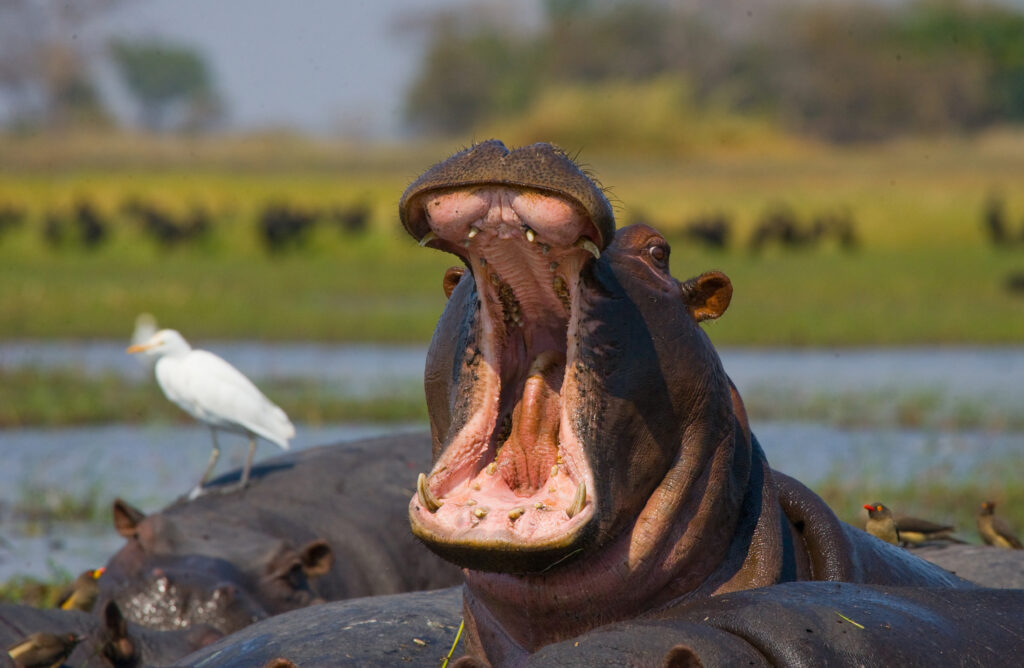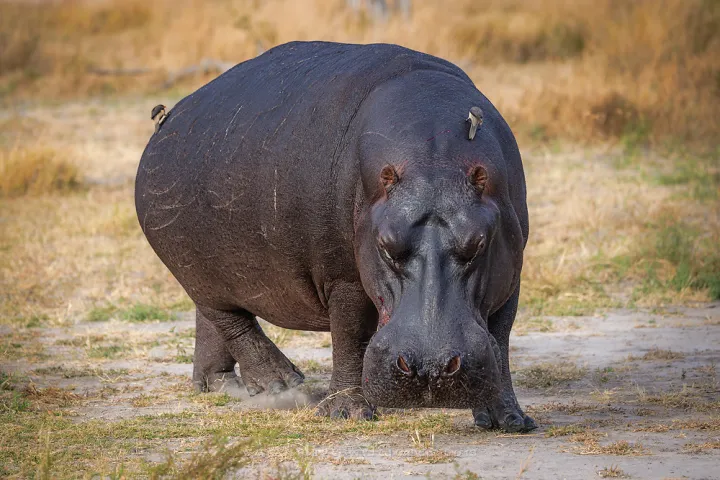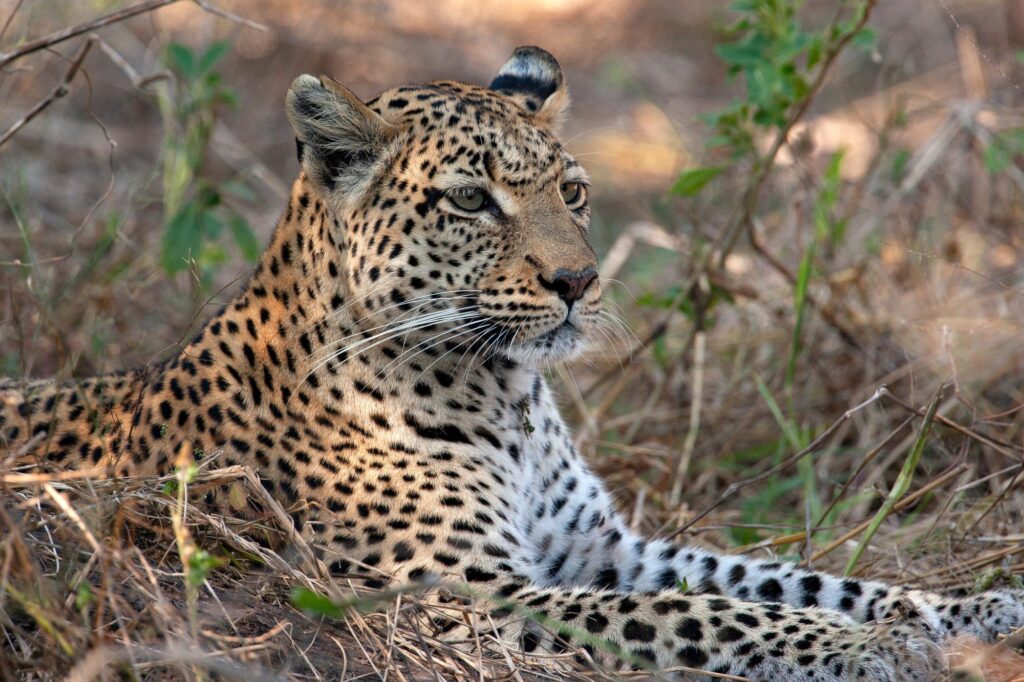Hippopotamuses are fascinating creatures well adapted to their semi-aquatic lifestyle in Africa’s wetlands.
These large mammals can often be found lounging in the water, with their eyes, ears, and nostrils peeking out. The ears and nostrils are positioned high on the head, allowing hippos to keep most of their body submerged while still being able to breathe and maintain awareness of their surroundings. Additionally, their ears and nostrils can fold shut to prevent water from entering when submerged.
Despite their impressive size and somewhat intimidating appearance, hippos are herbivores, feeding mainly on grasses and fruit.
Their powerful jaws and tusks are used for defense rather than hunting, as they are known to be quite territorial and protective of their young. One unique aspect of hippopotamuses is their need to keep their skin moist constantly.
Without sweat glands to help cool them down, hippos must spend a significant part of their day submerged in water or mud to prevent dehydration. Their natural secretion of “blood sweat” not only aids in keeping their skin hydrated but also serves as protection against the harsh African sun.
It’s incredible how these creatures have evolved to thrive in their watery environments, showcasing the resilience and adaptability of wildlife in the wild.
This article looks at all you need to know about the hippopotamus, let’s take a look.
What is a Hippopotamus Amphibius?
The hippopotamus, commonly referred to as the hippo, is a fascinating and unique mammal native to Africa. The word hippopotamus originates from Greek, meaning ‘river horse’. There are two distinct species of hippos: the large, or common hippo (Hippopotamus amphibius), and the smaller, lesser-known pygmy hippo (Choeropsis liberiensis).

Hippos are the third-largest living land mammals, following elephants and white rhinos. Despite their bulky appearance, hippos are well-adapted to their semi-aquatic environments, exhibiting remarkable agility both in water and on land.
Their distinctive physical features, such as webbed toes and powerful jaws, play crucial roles in their survival and daily activities.
Are Hippo Populations Endangered?
Hippos, specifically the common hippopotamus, are not currently considered endangered according to the IUCN Red List. Despite this classification, they are listed as vulnerable due to various threats such as habitat loss and poaching.
Their population is currently stable, which means that their numbers are not declining significantly but also not increasing. This stability provides hope for the conservation of hippos, but continued efforts are needed to ensure their long-term survival in the wild.
On the other hand, the pygmy hippopotamus is facing a more critical situation as they are classified as endangered on the IUCN Red List. Since 2006, their population has been decreasing rapidly, with less than 2,500 mature individuals remaining in the wild.
This decline is primarily attributed to habitat destruction, hunting for bushmeat, and human-wildlife conflict. Urgent conservation actions are needed to protect and preserve these unique and threatened species before it’s too late.
With targeted conservation efforts and increased awareness about their plight, there is hope that populations of pygmy hippos can be stabilized and restored in their natural habitats.
Challenges
Hippos, despite their size and strength, face numerous threats that put their existence at risk. One of the main challenges they confront is poaching, primarily for their ivory tusks and meat.
This illegal practice has significantly decreased hippo populations across Africa and threatens to push them toward extinction if not properly addressed. Additionally, habitat loss due to human development encroaching into their natural ecosystems further exacerbates the decline in hippo numbers.
As more land is cleared for agriculture and urbanization, hippos lose crucial feeding grounds and water sources, making it even harder for them to survive.
The survival of hippopotamus populations is increasingly threatened by human activities. Hunting poses a significant risk, with hundreds of hippos shot annually. This is often justified as a measure to reduce human-wildlife conflict, though the demand for hippo meat, fat, and ivory tusks is a major driver.
The population of common hippos in the Democratic Republic of the Congo has declined by over 95% at the start of the 21st century. In 2002 alone, approximately 5.5 tons of hippo teeth were exported from Uganda, equating to around 2,000 animals. Hippo teeth, not covered by many ivory bans, continue to be targeted by poachers.
In addition to hunting, habitat loss due to human encroachment is a critical threat. As human populations expand, wildlife habitats are converted for settlements, agriculture, and infrastructure.
This has confined hippos to protected areas, severely limiting their natural range. Both common and pygmy hippos face significant habitat loss and deforestation, further endangering their populations.
Human Populations-Wildlife Conflict
Human-wildlife conflict poses a significant threat to hippos as they come into contact with humans while searching for food or bodies of water. This often leads to conflicts where hippos are seen as dangerous pests and are killed in retaliation or self-defense.
The low birth rate of hippos further compounds these threats, as the slow reproduction rate makes it difficult for populations to recover from declines caused by human activities.
To ensure the survival of hippos in the wild, efforts must be made to address these threats through conservation measures such as protected areas, anti-poaching initiatives, and community-based solutions to mitigate human-wildlife conflicts. Only through collective action can we hope to
Solutions
Conserving the hippopotamus requires comprehensive strategies and community involvement. Organizations like The African Wildlife Foundation (AWF) are actively working on several fronts to protect these remarkable animals.
Hippo Behaviors and Diet
Hippos exhibit a range of unique behaviors and dietary habits:
Behaviors
Unlike humans, hippos do not have sweat or sebaceous glands. Instead, they secrete a viscous red fluid that protects their skin from the sun and may act as a healing agent.
Common hippos have a flexible social structure, typically forming groups of 20 to 100 individuals led by a territorial bull. Male hippos use vocalizations and physical displays to establish dominance and mark territory, often emerging from the water for dung showering to assert their presence.
During droughts, these groups may grow larger, leading to increased aggression and competition. In contrast, pygmy hippos are solitary, non-territorial, and usually avoid each other outside of mating.
Hippo Diet
Hippos are herbivorous and primarily graze on grass. Hippos emerge from the water at dusk to feed, traveling to familiar grazing areas along the banks and consuming around 40 kilograms (88 pounds) of food during four to five hours of grazing.
Their relatively low food intake is due to their sedentary lifestyle, which requires less energy. They often return to the same spot in the water after grazing, showcasing their habitual nature.
Habitats
Hippos, also known as river hippopotamuses, are predominantly found in sub-Saharan Africa where they inhabit waterways such as rivers, lakes, swamps, and estuaries. The term ‘river horse’ is derived from the Greek name for hippopotamus, reflecting their semi-aquatic lifestyle. These semi-aquatic mammals can be seen wading or lounging in the shallow waters of various African countries including East and West Africa.
They are well-adapted to their aquatic lifestyle with their barrel-shaped bodies and webbed feet that help them move effortlessly through the water. Hippos spend much of their day submerged in water to stay cool and protect themselves from the harsh African sun. One of the best places to see them is in Khwai and Moremi Game Reserve.

In contrast to their larger cousins, pygmy hippos can be found in the lush tropical rainforests and swamps of four West African countries: Côte d’Ivoire, Guinea, Liberia, and Sierra Leone. Their smaller size allows them to easily navigate through dense vegetation as they forage for food like leaves, fruits, and grasses.
Pygmy hippos are much more elusive than common river hippos due to their less accessible habitat. Despite these differences in habitat and size, both species play vital roles in their ecosystems as keystone species helping maintain the balance of their respective environments.

Hippos inhabit various environments across Africa:
- Common Hippos: These large hippos are predominantly found in East Africa, south of the Sahara Desert. They thrive in wetlands, rivers, and swamps, where they can easily access water and food.
- Pygmy Hippos: These smaller hippos have a more restricted range, primarily inhabiting the forests of West Africa. They are shy, solitary creatures, and their populations are now endangered due to habitat loss and hunting.
Conclusion
It’s crucial to remember that hippos are essential to the ecosystems they live in.
They play a vital role in maintaining the health and balance of their environments. Sadly, they face significant threats from human activities like hunting and habitat loss.
By engaging with the community, protecting their habitats, and practicing sustainable conservation, we can work towards ensuring the survival of both common and pygmy hippos. Continued efforts to preserve these magnificent creatures are imperative for the benefit of future generations.
As custodians of the great mammals and the Okavango Delta Wetlands, we at Khwai Expeditions camp are privileged to contribute to their survival for generations to come.
Frequently Asked Questions About Hippos
What do hippos eat?
Hippos are herbivores, primarily grazing on grass. They also eat fruits and other vegetation they find near their aquatic habitats. Common hippos typically leave the water at night to graze for several hours.
Why are hippos so aggressive?
Hippos are known for their aggressive behavior, particularly when they feel threatened or if their territory is encroached upon. Female hippos, especially when pregnant or protecting their calves, exhibit heightened aggression towards humans and other animals. This aggression helps protect their young and maintain their dominance within their social structures.
What animal eats hippos?
While adult hippos have few natural predators due to their size and aggression, young hippopotami occasionally fall prey to predators such as lions, hyenas, and crocodiles. Humans also pose a significant threat through hunting.
How much do hippos weigh?
Common hippos can weigh between 1.4 to 5 tons (2,800 to 10,000 pounds), while pygmy hippos are much smaller, weighing between 160 to 275 kilograms (352 to 606 pounds).
Where do hippos live?
Hippos are found in sub-Saharan Africa. Common hippos inhabit wetlands, rivers, and swamps in East Africa, while pygmy hippos are limited to the forests of West Africa.
Can hippos swim?
Despite spending much time in the water, hippos cannot swim. They move by walking along the riverbed or propelling themselves through the water using their powerful legs.
How fast are hippos?
Hippos can move surprisingly fast for their size. On land, they can run up to 30 kilometers per hour (19 miles per hour) for short distances.
How long do hippopotamuses live?
Hippos can live up to 50 years in the wild, though many do not reach this age due to threats from predators and human activities.
What color are hippopotamuses?
Hippos have purple-gray or slate-colored skin with pinkish areas around their eyes and ears. Their skin is thick and virtually hairless, except for some bristle-like hair on their heads and tails.
What is the bite force of hippo teeth?
A hippo’s bite force is incredibly powerful, measuring around 1,800 PSI (pounds per square inch). This force allows them to defend themselves effectively and assert dominance.
What to do if you see a hippo?
If you encounter a hippo in the wild, it is crucial to maintain a safe distance and avoid provoking the animal. Hippos are highly territorial and can become aggressive if they feel threatened. Observe from afar and never attempt to approach or feed them.




